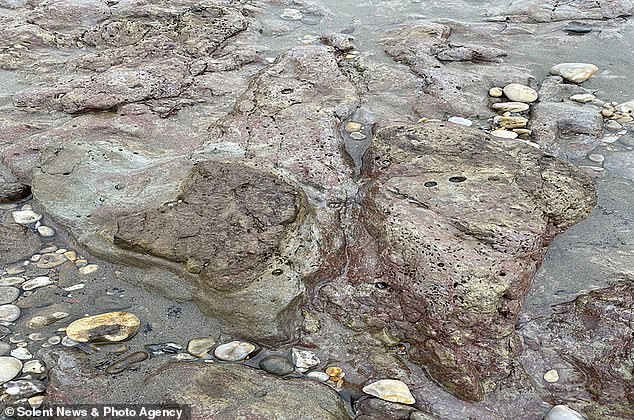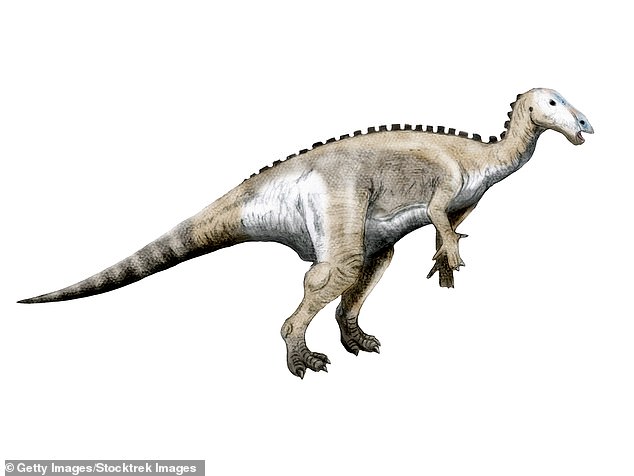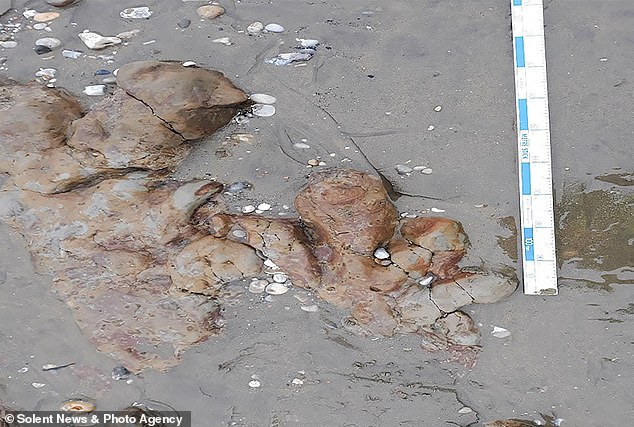Dino-mite discovery! Dinosaur footprints uncovered on a beach on the Isle of Wight belongs to a 125million-year-old creature that was TWICE the size of car
>
- The prints were discovered accidentally in Yaverland during excavations
- They are believed to belong to the 125-million-year-old mantellisaurus
Engineers on the Isle of Wight were in for a surprise this week, after they found impressively well-preserved dinosaur footprints.
The prints were discovered by chance in Javerland, during excavations that were being carried out to strengthen sea defences.
The three-toed tracks are believed to belong to a 125-million-year-old creature called a mantellisaurus.
Mantellisaurus reached a length of 23ft (seven metres) when it roamed Britain, according to experts from the Dinosaur Island Museum in Sandown.
Dr Martin Munt, curator at the museum, said: ‘A full-grown Mantelisaurus would have been twice the length of an ordinary car, moving at thunder-slow speed with huge strides that clearly left their mark in time.’

Engineers on the Isle of Wight were in for a surprise this week, after they found impressively well-preserved dinosaur footprints.

The three-toed tracks are believed to be from a 125-million-year-old creature called Mantelisaurus (artistic impression).
Engineers at the Environment Agency made the discovery during excavation work to improve flood defenses near a seaside café in Yaverland.
Monuments and fossils are often found on the Isle of Wight.
Mantelisaurus is thought to have weighed 1,653 pounds (750 kg), and unlike many other dinosaur subspecies, it walked around on its hind legs.
“We can’t be completely sure of the identity of this print, but the three-toed feet make it likely that mantellisaurus existed here, and not just on other parts of the south coast where it was more common – or so we thought until now.” Mont said.
Engineers who discovered the footprints were at the site to draw up plans to improve the flood defenses of more than 600 properties in Shanklin and Yaverland.
While working, they did not expect to discover dinosaurs.
Nick Gray, Director of Floods and Coastal Risk at the Environment Agency in the Solent and Inland, said: “The dinosaurs where our team works bring the old and the new together – the modern challenges of fighting climate change with a timeline we can only imagine.” South Downs area.
We’ve all read stories and watched movies, but this just gives us a glimpse of what life was like.

Engineers who discovered the footprints were at the site to draw up plans to improve the flood defenses of more than 600 properties in Shanklin and Yaverland.
Experts hope that this discovery will strengthen the Isle of Wight’s position as the dinosaur capital of Britain.
added Stuart Nunn, Heritage Leader at JBA Consulting “This represents a very significant and significant discovery for the project, as the finding of the new footprints demonstrates that the land on which dinosaurs walked likely extended along the entire length of Yaverland’s shore.”
“The latest seizure cements the Isle of Wight as Britain’s dinosaur capital.”
The discovery comes shortly after the remains of what may have been the largest predatory dinosaur ever discovered in Europe were discovered on the Isle of Wight.
Paleontologists say the massive crocodile-faced dinosaur — at 32.8 feet (10 meters) long and roughly the size of a London bus — lived 125 million years ago and weighed several tons.
The “giant killer” was a member of the spinosauridae, the first dinosaurs known to swim, so it may have been able to hunt in water as well as on land.
It probably lived at the beginning of a period of rising sea levels and stalked the waters of lakes and sand plains in search of food.
(tags for translation) Daily Mail
